
On average, more than 40,000 vessels, 900,000 passengers and 200,000 tons of cargo pass through the gates of Chicago's Harbor Lock each year, and the lock itself opens and closes 11,500 times annually. But the 72-year-old Harbor Lock on Lake Michigan at the mouth of the Chicago River, owned and operated by the U.S. Army Corps of Engineers (USACE), has been deteriorating for the last 15 years. The lock gates have been leaking, and 10 gate breakdowns have occurred since 1991.
According to a 2006 article at chicagobusiness.com, the deterioration of the lock had the city worried about the potential for disrupting recreational and commercial boating, reducing the region's water supply and threatening downtown Chicago with flooding. Finally, new lock gates are being installed as part of a major overhaul project.
Watery Platform Calls for a Ringer
The lock replacement project is being handled by general contactor James McHugh Construction. It hired Central Contractors Service of Chicago to provide the lifting power to get the new gates in place.
Central's decades of experience in lift planning made it easier to select the proper equipment. It recommended its 300-ton-capacity Manitowoc 4100W S-3 Ringer crane with a 140-foot boom, a total picking radius of approximately 72 feet and a capacity-enhancing ringer attachment. There were several larger Manitowoc cranes to choose from, but Central felt that the 4100W S-3 Ringer, mounted on a barge, would be the most economical and would allow for better distribution of the point loading.
"When a crane must be mounted on a barge, the crane's load charts are decreased because of the lack of a reverse force," John Martello, general manager, Central Contractors Service, explains. "The relative instability of a floating platform has negating effect on the load weight able to be picked.
"Adding a ringer and pedestals to a crane distributes loading over a larger area and can increase the lifting capacity dramatically," he continues. "The ringer attachment on the 4100W was utilized to better spread the weight of the crane on the surface of the barge. Instead of all the weight of the crane being carried on just two tracks, the weight is distributed to 11 points. This allows point loads to be reduced."
It's a Lock for Central
The crane was erected on the barge at the Iroquois Landing dockside facility in Chicago, IL. The new fabricated gates, with a total weight of 180,000 pounds, were loaded up and the barge was towed by tugboat to Navy Pier, a trip of three hours.
The lift and installation of the first gate took place on December 2, 2010, and the second gate was set a week later, on December 9. Both procedures went without a hitch.
According to Ken Derry, Central's crane operator, the USACE was impressed with the crane and the operation. "USACE required that the maximum list of the barge during the gate picks be no more than 2%. The actual list during the pick was 0.00%. This number is amazing, considering the weight of the pick and its location on the water almost 90 feet away from the crane."
The barge and crane were to be repositioned to set the final two gates in mid-January.
About Central Contractors Service
Central Contractors Service serves markets in greater Chicago, northern Indiana, southern Illinois, St. Louis, Missouri, and Iowa, and has been a member of the ALL Erection & Crane Rental Corp. Family of Companies since 1977. ALL, the largest privately owned crane sales and rental company in North America, offers its fleet of cranes, aerial work platforms, boom trucks, material handlers, and other lift equipment from strategic locations throughout the U.S. and Canada.




















